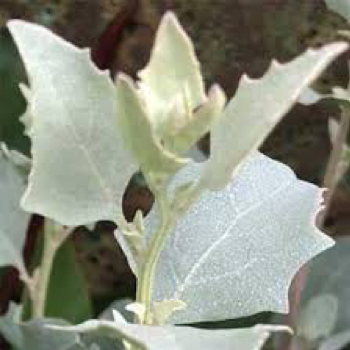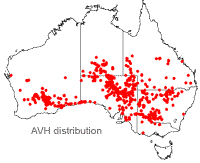
Atriplex Nummularia
Common name: Old Man Saltbush
I grow best: Full sun
· Drought resistant & tolerates light frost
· Large shrub, height up to 3m, width up to 5m
· Dry, well-drained sandy soils, adapts to most soils
· Flowers – winter
· Attracts – birds
· Edible leaves & seeds
Looks like: Has attractive silver foliage, growth habit tends to be sprawling to around 3 metres high and can get to 5 metres wide. Its leaves, 1–3cm long, have a scaly coating which gives them an attractive silvery grey colour. The shape of the leaves may vary considerably from elliptical to almost circular, both on the same plant and in different populations of the species. Produces very small flowers which are wind pollinated. Male and female flowers occur on separate plants. The female flowers are in dense clusters along panicles about 20 cm long and the male flowers are in disjunct globules at the ends of branches. After fertilisation, leafy bracts of the female flower become enlarged and surround the developing seed. These fruiting bracteoles are attached only at the base and are approximately 1cm wide in the shape of a fan.
Habitat & Growing: Naturally growing in arid areas in all states of Australia, this is a very useful plant to grow as it tolerates high levels of salinity, alkalinity, severe drought and is good for stock feed. Will not tolerate water logging or excess humidity. Can be propagated by cuttings or seed. Propagation by seed is usually done by sowing the fruiting bracteoles. Germination rates are increased by rubbing the fruits with the hands under running water for several minutes or soaking them in water for at least an hour. The fruits can then be sown directly into the soil or first placed into a Viro-cell for sowing. The best times to sow seed are in autumn, early winter and spring. Can placed into a mixture of sand and potting mix, making sure that there is plenty of ventilation and that mist is avoided to prevent the development of a leaf spotting fungus. It is a very adaptable plant and can tolerate severe droughts as well as periodic flooding. It is frost and salt tolerant. A. nummularia also recovers well after intense defoliation, making the plant very suitable for pruning. It will tolerate most soils but is best grown in a well drained position which is sunny for most of the day. An extremely versatile plant that has frequently been used as a fodder plant for cattle and sheep and is often planted near property homesteads as a shelter. It provides a useful windbreak which, along with readily visible leaves at night, makes it suitable for roadside plantings. The ornamental foliage can be pruned to make hedges and provides an attractive silvery contrast against darker plants in the garden.
| Family | Amaranthaceae |
| Plant Type | Large shrub |
| Width | 5 |
| Flowering Time | Winter |
| Soil Type | Sandy, Clay, Loamy, Sandy loam, Clay loam, Saline, Poor soil |
| Climate Zone | Sub-tropical, Warm temperate, Cool temperate, Mediterranean, Semi-arid, Arid |
| Growth Habit | Deciduous |
| Soil Moisture | Dry, Well-drained |
| Special Uses | Edible |
| Height | 3 |
| Flower Colour | Cream |
| pH Level | Neutral, Alkaline |
| Plant Environment | Low maintenance garden, Drought resistant |
| Light | Sunny |
| Lifespan | Perennial |
| Frost Tolerance | Tolerates light frost |
Distribution:

Traditional uses: Edible foliage and seed, it can be dried to be added to savoury dishes, or used fresh. The leaves of the shrub are ground and the leaves and roots steeped into water. They would then bathe any skin abrasions in the water to help heal them. Oldman saltbush was also used by Indigenous Australians as windbreaks, firebreaks and shade, and used it to optimise soil conditions for agriculture.
Eco Friendly Seed Starting Kit: Propagation Instructions
1.Soak Oldman Saltbush seed overnight in water.
2.Once ready to sow the seed, place coir tablet in a container with warm water.
3.Once the coir tablet has expanded, pour excess water out of the container and transfer the coir into the peat pot.
4.Place seeds in pot and cover lightly with the coir.
5.Keep in a sheltered position where it can receive morning sun, gradually exposing to full sun.
6.Keep moist until germination.
7.Once seed is germinated, you can plant in next size pot or plant in your garden.
8.Ensure pot is under soil level, push down gently and water well.

